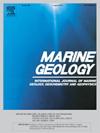Development shifts on the emerging Järve coast (Estonia) in Late Holocene
IF 2.6
3区 地球科学
Q2 GEOSCIENCES, MULTIDISCIPLINARY
引用次数: 0
Abstract
This study identifies a sequence of accretional paleospits and beach ridges at the Järve coast, which developed over the past 4000 years (4 ka) mostly through coastal progradation and land emergence driven by glacial isostatic adjustment (GIA). Using optically stimulated luminescence dating, LiDAR elevation data, historical cartography, and recent instrumental metocean forcing data, we analyze the historical developments in relative sea level (RSL) and major shifts in the region's geomorphology from the Mid- to Late-Holocene. From 7.3 to 4 ka, the GIA induced uplift with local rate of about 2.2 mm/a facilitated land emergence and the formation of the Järve shoal which was exposed to storms from west, south and east; from 4 to 3 ka, the shoal evolved into a sandy island with spits; between 3 and 1.5 ka, the barrier island became connected with the Saaremaa mainland while the still emerging paleospits distanced from the sea. From 1.5 ka to 1850 CE, westerly forces were cut off; cooling climate during the Little Ice Age and tree logging facilitated formation of nearshore dune belt. In the mid-20th century, a reversal in RSL occurred, as the global sea level rise exceeded the local uplift. Concurrently to the Baltic Sea winter ice extent decrease, Järve ice days have reduced by 46 % from 1750 to 2023 CE. This reduction has exposed the coast to increased wave energy and storm surges from winter storms, resulting in an approximate 85-m shoreline recession at Järve and sediment accumulation near downdrift Nasva port.
晚全新世新兴Järve海岸(爱沙尼亚)的发展转变
在过去4000年(4ka)的时间里,通过冰川均衡调整(GIA)驱动的海岸进积和陆地涌现,在Järve海岸形成了一系列增生古喷口和滩脊。利用光学激发发光测年、激光雷达高程数据、历史制图和最近的仪器海洋强迫数据,我们分析了相对海平面(RSL)的历史发展和该地区从中到晚全新世的主要地貌变化。7.3 ~ 4 ka, GIA诱发的隆起以约2.2 mm/a的局部速率促进了陆地的出现和Järve浅滩的形成,该浅滩暴露于来自西、南、东的风暴中;从4到3 ka,浅滩演变成一个沙岛,有吐槽;在3至1.5 ka之间,堰洲岛与萨雷马大陆连接起来,而仍在出现的古喷口离海很远。公元1.5 ka至1850年,西风切断;小冰期气候变冷和树木砍伐促进了近岸沙丘带的形成。在20世纪中期,由于全球海平面上升超过了局部上升,RSL发生了逆转。与波罗的海冬季冰面积减少同时,Järve冰日数从1750年到2023年减少了46%。这种减少使海岸暴露在增加的波浪能量和冬季风暴带来的风暴潮中,导致Järve的海岸线退缩了大约85米,并在纳斯瓦港附近形成了沉积物堆积。
本文章由计算机程序翻译,如有差异,请以英文原文为准。
求助全文
约1分钟内获得全文
求助全文
来源期刊

Marine Geology
地学-地球科学综合
CiteScore
6.10
自引率
6.90%
发文量
175
审稿时长
21.9 weeks
期刊介绍:
Marine Geology is the premier international journal on marine geological processes in the broadest sense. We seek papers that are comprehensive, interdisciplinary and synthetic that will be lasting contributions to the field. Although most papers are based on regional studies, they must demonstrate new findings of international significance. We accept papers on subjects as diverse as seafloor hydrothermal systems, beach dynamics, early diagenesis, microbiological studies in sediments, palaeoclimate studies and geophysical studies of the seabed. We encourage papers that address emerging new fields, for example the influence of anthropogenic processes on coastal/marine geology and coastal/marine geoarchaeology. We insist that the papers are concerned with the marine realm and that they deal with geology: with rocks, sediments, and physical and chemical processes affecting them. Papers should address scientific hypotheses: highly descriptive data compilations or papers that deal only with marine management and risk assessment should be submitted to other journals. Papers on laboratory or modelling studies must demonstrate direct relevance to marine processes or deposits. The primary criteria for acceptance of papers is that the science is of high quality, novel, significant, and of broad international interest.
 求助内容:
求助内容: 应助结果提醒方式:
应助结果提醒方式:


